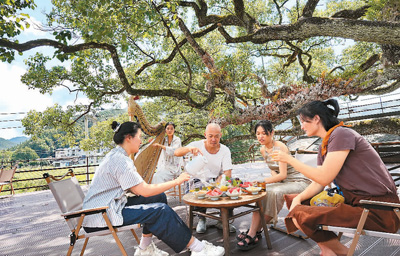SE China’s Fujian cultivates forest tourism, enriches tourists’ experiences

Some tourists enjoy tea in Wuyi Mountain National Park in southeast China’s Fujian Province. (Xinhua/Chen Ying)
The long, languid days of summer are graced by the cool touch of mountain breezes. Strolling through mountains, forests, and rivers, one can admire the endless greenery, listen to the nearby chirping of birds and the buzzing of cicadas, and breathe in the fresh, sweet air—it’s a delightful experience.
It’s an experience that can be had in southeast China’s Fujian Province, with its remarkably high forest coverage rate of 65.12 percent. The province has been actively tapping into the potential of forest resources and introducing diverse eco-tourism products, enriching tourists’ experiences.
The province currently has five World Heritage sites, three Global Geoparks, one national park and 154 forest parks at or above the provincial level.
“Through strengthening policy support and guiding featured development paths, the province is promoting the deep integration of forests with culture and tourism in various regions, creating diverse new forms of forest tourism,” said an official of the forestry department of Fujian.
Boasting a forest coverage rate of 72.96 percent, Zhouning county of Ningde city is known for a pleasantly cool climate in summer.
“As a natural oxygen bar in China and a national summer resort destination, Zhouning has rolled out summer tourism products including wellness vacations, leisure activities, and study tours,” said a relevant official from the county’s culture and tourism bureau.
“The cool temperature, fresh air, and beautiful scenery make jogging here especially enjoyable,” said a tourist surnamed Ye from Fuzhou, capital of Fujian, who was jogging along a mountain path of the county’s Xianfeng mountain. She planned to stay overnight in a guesthouse on the mountain in order to view the beautiful sunrise and sea of clouds the next morning, and then taste the local cuisine.
In May this year, Wuyi Mountain National Park’s No. 1 Scenic Byway, located in Nanping city, started operation. Spanning approximately 251 kilometers, the scenic way brings together the most important natural ecosystems, unique natural landscapes, exquisite natural heritage, and abundant biodiversity of the national park. It also features local culture such as tea culture.

Photo shows homestay hotels in Xianfeng Mountain, Zhouning county, Ningde city, southeast China’s Fujian Province. (Photo/Li Hongyuan)
Some areas have taken extra steps to combine the natural beauty of the forests with extra services, particularly those services associated with the wellness industry.
In early 2020, the forestry department and several other departments of Fujian jointly issued a plan on accelerating the development of the forest wellness industry, which included offerings such as natural healing, sleep therapy, hot spring therapy, and dietary health treatments. Currently, Fujian has established 114 provincial-level forest wellness bases, 42 forest wellness towns and 16 such cities.
Datian county of Sanming city is emerging as a hotspot for forest wellness tourism. It has built forest wellness trails spanning 257 kilometers, and received 1.51 million tourist visits in 2023, with 228 million yuan (about $31.89 million) in revenue from the forest wellness industry.
The Hanlinquan forest wellness base, located near the county seat, is built near 1,000 hectares of forest. Visitors can take a walk and practice yoga and tai chi under professional guidance.
There is also a health management center that provides swimming, spa treatments, health lectures, and nutritional dining options. A tourist from Shanghai surnamed Chen said she almost had different meals every day during her four-day stay there.
“We not only guide visitors to nearby towns and counties to experience natural scenery and local life, but also tailor our wellness programs to meet the specific needs of our guests,” said Xiao Shoucan, the base’s operation director.
“The base receives over 100,000 tourist visits annually. In the past two months, the base’s 200 plus beds have been almost fully occupied, with the majority of guests coming from Xiamen, Zhangzhou, Quanzhou of Fujian Province and Shanghai,” Xiao added.
Other areas have turned their focus to the wildlife that can be found within the forests.
Mingxi county of Sanming city has become a well-known bird-watching destination, with a complete bird-watching cultural and tourism industry chain. It has established bird-watching bases, routes, and standardized bird-watching spots, attracting over 30,000 bird-watching enthusiasts annually.
Located in Junzifeng national nature reserve, Ziyun village boasts a rich biodiversity, with over 300 recorded species of birds.
Yang Cheng, a bird guide, introduced an eco-friendly bird-watching business to the village in 2016. Yang and other villagers developed bird-watching spots, built homestay hotels, and trained guides. Their efforts have attracted domestic visitors and overseas tourists from across 30 countries and regions.
Yang also designed other programs, such as learning to make local Hakka snacks. “Through activities such as bird-watching, stargazing, and experiencing Hakka folk customs, parents and children can gain knowledge and enjoyment in a natural environment,” he explained. Yang introduced that he and his team have designed 37 study tour products that fall into 12 categories, which can be tailored according to the needs of tourists.
Photos
Related Stories
- Inbound travelers surge amid policy boost
- Rural China's ancient architectural treasures attract tourists
- China continues to see rising number of foreign visitors thanks to favorable policies
- China reports 129.9-percent growth of foreign visitors in first seven months
- China targets scalping of scenic spot tickets
Copyright © 2024 People's Daily Online. All Rights Reserved.









